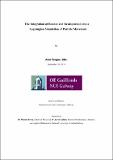| dc.description.abstract | The phenomenon of particle transport in turbulent flows has been studied extensively using Direct Numerical Simulation (DNS) over the past few decades. One of the most useful DNS approaches is Lagrangian simulation. Lagrangian simulations of particles in turbulent flows have provided much information regarding particle deposition to surfaces and particle-turbulence interactions. Because individual particle trajectories are calculated in Lagrangian simulations, details of particle motion are accessible that are unattainable by experiment, thus making Lagrangian Modelling a highly powerful tool in particle transport simulation.
A Computational Fluid Dynamic program called OpenFOAM[1] is used as a base and modified to incorporate particle-surface interactions, bounce and re-entrainment. To model such behaviour, particles¿ potential functions for a population of particles are developed, governing sticking and re-entrainment of particles. When a particle strikes a surface using most existing models, the particle adheres to the surface (perfect sink). In this work, there are two outcomes that occur which are dependent on the velocity of the particle when its impacts with the surface. At a low impact velocity the particle adheres, but as the impact velocity increases, the particle may bounce if the velocity of impact is greater than a critical velocity Vcr defined as
Vcr=(2Ea/M)(1/2)
where m is the mass of the particle, Ea = Em + Es is the surface adhesion as detailed by Johnson et al. (1971)[2], and is the sum of the mechanical potential energy Em and the surface adhesion energy Es.
While the phenomenon of resuspension has been studied extensively on its own, very little work has been carried out that included resuspension in a standard Lagrangian model. In the present work, the critical velocity is calculated and if the critical velocity is less than the velocity of the flow at the position of the particle, the particle is resuspended into the flow at a velocity dependent on the particle properties and energy remaining after the particle has overcome the adhesion energy.
To validate the presented theory, three test cases were chosen. The first test case was based on the experimental deposition data for 33-36 micron particles, collected by Paw and Braaten (1992)[3],. It is evident that the simulated Vcr is well within the values of ideal deposition and net deposition as presented by Paw and Braaten (1992)[3]. The second test case was based on the simulated work of Li and Ahmadi (1993)[4], who examined bounce for 1-10 micron particles and obtained a critical approach velocity above which particles bounced. When the critical approach velocity is compared with Vcr, it is clear that there is very good agreement for particle sizes above 4 µm. The final test case chosen was a sand transport simulation. When the sand in freefall test case is examined, it is found that the settling velocity agrees well with those values presented by Fentie et al. (2004)[5] and the spatial distribution in this test case, in a 5 m s-1 wind, agrees well with the spatial distribution as presented by Kang and Guo (2006)[6] , who modelled aeolian sand transport. | en_US |


